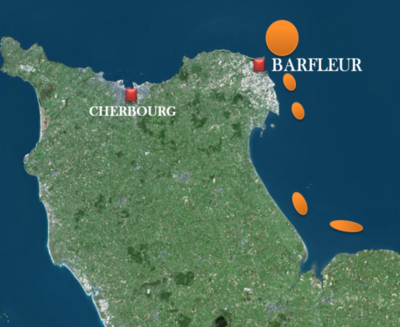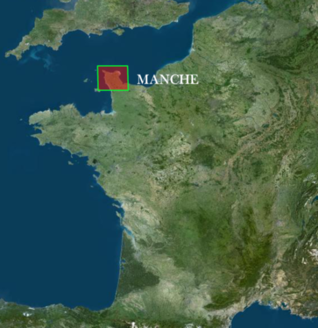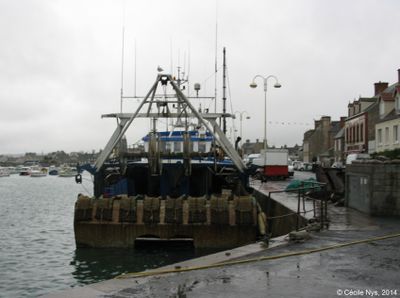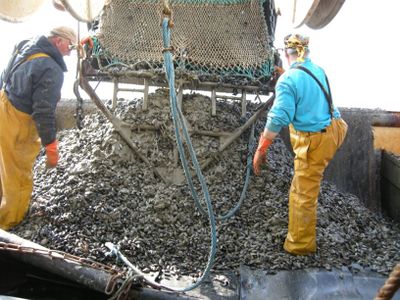Difference between revisions of "Case study Barfleur"
| Line 6: | Line 6: | ||
[[Image:Fig Barfleur.png|400px]] [[Image:Fig 2 barfleur.png|318px]] | [[Image:Fig Barfleur.png|400px]] [[Image:Fig 2 barfleur.png|318px]] | ||
| − | + | Figure 1: Distribution of the five natural mussel (Mytilus edulis) deposits of eastern Cotentin (Cochard et al., 2013) | |
Fishing takes place on deposits that all display significant interannual variability in terms of biomass. Indeed, between 1980 and 2010, the annual biomass indices, all deposits combined, are comprised between 1 000 and 20 000 tonnes (Personal communication from the CRPMEM BN, 2014). Therefore, a scientific monitoring, carried out by Ifremer, was set up to better understand the stock and adjust fishing effort to the available resource. Its exploitation is seasonal; fishing is generally only open between June and November, depending on the abundance and size of mussels on each deposit. The seasonality of fishing implies that all vessels practice at least one other fishing trade; for most, that is dredging for Great Atlantic scallops and/or trawling<ref>MONTFORT M-C. et TESSERON R., 2006. Moules de l’Est Cotentin, Commercialisation. Regional Committee for Maritime Fisheries and Marine Fish Farms of Lower Normandy. 74 p.</ref>. | Fishing takes place on deposits that all display significant interannual variability in terms of biomass. Indeed, between 1980 and 2010, the annual biomass indices, all deposits combined, are comprised between 1 000 and 20 000 tonnes (Personal communication from the CRPMEM BN, 2014). Therefore, a scientific monitoring, carried out by Ifremer, was set up to better understand the stock and adjust fishing effort to the available resource. Its exploitation is seasonal; fishing is generally only open between June and November, depending on the abundance and size of mussels on each deposit. The seasonality of fishing implies that all vessels practice at least one other fishing trade; for most, that is dredging for Great Atlantic scallops and/or trawling<ref>MONTFORT M-C. et TESSERON R., 2006. Moules de l’Est Cotentin, Commercialisation. Regional Committee for Maritime Fisheries and Marine Fish Farms of Lower Normandy. 74 p.</ref>. | ||
| Line 12: | Line 12: | ||
[[Image:Fig 3 barfl.jpg|center|400px]] | [[Image:Fig 3 barfl.jpg|center|400px]] | ||
| − | :::::::: | + | ::::::::Figure 2: Port of Barfleur |
Mussels are harvested using fishing dredges, the characteristics of which are determined by local regulations. This fishing gear is dragged along the bottom, and is used for collecting mussels that rest on, or are more or less buried in, the sediment. It consists of a frame on which is fixed a mesh pouch, and of a lower bar (Figure 3) | Mussels are harvested using fishing dredges, the characteristics of which are determined by local regulations. This fishing gear is dragged along the bottom, and is used for collecting mussels that rest on, or are more or less buried in, the sediment. It consists of a frame on which is fixed a mesh pouch, and of a lower bar (Figure 3) | ||
[[Image:Fig 4 barfl.jpg|center|400px]] | [[Image:Fig 4 barfl.jpg|center|400px]] | ||
| − | ::::::: | + | :::::::Figure 3: Mussel dredge (© CRPMEM of Lower Normandy) |
===<span style="color:#3a75c4; Font-size: 130%">'''<small>Structure of the governance</small>'''</span>=== | ===<span style="color:#3a75c4; Font-size: 130%">'''<small>Structure of the governance</small>'''</span>=== | ||
Revision as of 10:36, 7 July 2014
The mussel fishery of eastern Cotentin (Lower Normandy, France)
Contents
Presentation and history
The wild mussel from eastern Cotentin, Mytilus edulis, is fished using dredges since 1962, although some deposits that are accessible on foot at low tide have been exploited by the local population for a long time. There are five main deposits exploited at sea, all between 5 and 50 meters depth[1]: four of them are in the department of Manche, offshore of Barfleur, Moulard, Réville and Ravenoville and one is offshore of Grandcamp in the Calvados (Figure 1). In terms of area, the Barfleur deposit, which is the most northern, is by far the most important French fishing deposit of wild mussels, with over 2 000 ha[2].

 Figure 1: Distribution of the five natural mussel (Mytilus edulis) deposits of eastern Cotentin (Cochard et al., 2013)
Figure 1: Distribution of the five natural mussel (Mytilus edulis) deposits of eastern Cotentin (Cochard et al., 2013)
Fishing takes place on deposits that all display significant interannual variability in terms of biomass. Indeed, between 1980 and 2010, the annual biomass indices, all deposits combined, are comprised between 1 000 and 20 000 tonnes (Personal communication from the CRPMEM BN, 2014). Therefore, a scientific monitoring, carried out by Ifremer, was set up to better understand the stock and adjust fishing effort to the available resource. Its exploitation is seasonal; fishing is generally only open between June and November, depending on the abundance and size of mussels on each deposit. The seasonality of fishing implies that all vessels practice at least one other fishing trade; for most, that is dredging for Great Atlantic scallops and/or trawling[3]. Fishing concerns 64 vessels for the 2013 season and depending on the year, between 100 and 250 sailors exploit this product. For the 2013 fishing season, approximately 6 000 tonnes of mussels were landed. The two main landing ports for commercially harvested mussels are Saint-Vaast la Hougue and Barfleur (Figure 2).
- Figure 2: Port of Barfleur
Mussels are harvested using fishing dredges, the characteristics of which are determined by local regulations. This fishing gear is dragged along the bottom, and is used for collecting mussels that rest on, or are more or less buried in, the sediment. It consists of a frame on which is fixed a mesh pouch, and of a lower bar (Figure 3)
- Figure 3: Mussel dredge (© CRPMEM of Lower Normandy)
Structure of the governance
The inshore mussel fishery of eastern Cotentin is defined as a very structuring fishery for the territory. It has a very strong socio-economic importance because it drives the development of the local economy. Since the harvest of the mussel by large vessels in the years 1979-1980, fishermen have gained awareness of the need to establish a sustainable management of the resource. A collective management of this resource with the involvement of professionals and the authorities as well as with scientific support has been developed to establish a regulatory management system since 1980.
Indeed, in Lower Normandy, here is a true co-management system for the mussel fishery in French territorial waters. In this system, the mussel resource management initiative originates mainly from the local users[4]. Decision-making is participatory, giving stakeholders the opportunity to voice their positions. Fishermen enjoy a degree of autonomy because they hold some control over the management of the fishery[5]. However, the regulatory decision-making falls to the central (national level) or decentralised (regional level) authorities.
The Regional Committee for Maritime Fisheries and Marine Fish Farms of Lower Normandy (Comité Régional des Pêches Maritimes et des Elevages Marins de Basse-Normandie - CRPMEM BN) is the referent occupational structure within the eastern Cotentin mussel fishery. It has notably for objective to ensure and to manage fishing within the 12 nautical miles through the establishment of regulations. Within this committee, the “Mussel” Commission is the authority dedicated to the management of the mussel fishery across this territory. It is the place of gathering and exchanges between local fishermen representatives, fishermen, and the CRPMEM BN. It enables opinions to be transmitted up the ladder and proposes management measures that will be validated by the State authorities through the Interregional Directorate for the Sea (Direction Interrégionale de la Mer -DIRM) This is how a system of licences was established in 1980. The issuance of these depends on a set of eligibility criteria as defined by the “Mussel” Commission. In addition to this system, there are other measures of exploitation of the resource decided at this commission: delineation of the five mussel deposits of eastern Cotentin, setting of opening and closing periods depending on each deposit, authorised fishing gears, fishing periods (schedule), quotas, mussel landing locations, minimum catch size (4 cm). Finally, In order to satisfactorily manage this fishery, a control system was implemented, at the request of the fishermen, in addition to the controls of State services. Indeed, the CRPMBN pays a sworn guard. The latter has the authority to record all offences of fishermen against the regulation, through official statements of offence.
Outlook for the fishery
The governance of the mussel fishery is an example of co-management where professionals work together with the authorities and scientists. For the past forty years, there has been a real rise in the awareness of the fishermen on the need to manage this resource. It is in this context that the “Mussel” Commission of the CRPMEM BN was established. The improved consideration of the various opinions originating from all categories of fishermen (consultation) and the cooperation between these stakeholders led to a rapid development of the latter. The Barfleur mussel fishery relies on regional governance based on local co-management. The interviews conducted as part of the GIFS Project[6] allowed to summarise the principal means by which the existing structures contribute to the environmental, socio-cultural and economic sustainability of the eastern Cotentin wild mussel fishery.
The environmental dimension, first item of the sustainable development triptych, is one of the pillars of this fishery and its governance. The fishermen have implemented a management on the basis of the availability of the resource, notably through the development of a quota/man/day. To better understand the deposit and adjust fishing effort to the resource, an assessment of the stock of mussels is carried out prior to the start of each fishing season. Various scientific projects conducted with Ifremer[7] help improve the knowledge of the resource. The Barfleur mussel is a resource that is supervised by an economic management based on biological parameters. The socio-cultural aspect, another key element of sustainable development, is present within the community of fishermen. There are several initiatives of fishermen and other bodies such as Normandie Fraîcheur Mer (NFM) to improve the value-enhancement and promotion of the Barfleur mussel and the communication about it. The development of joint projects oriented towards tourism can be seen as a key to this success. The aim is to promote the development of this territory by promoting the products of fishing and using the mussel as a leading product to improve tourism attractiveness. In addition, a participatory quality approach has been established and developed by the fishermen themselves despite a lack of cohesion and harmonisation of marketing means. However, this trend is more pronounced within the fishermen community of Barfleur in other municipalities across the territory. This can be explained by an ancient social context. Moreover, women play an important role in the promotion and marketing of the product, they are integrated into the sector. Finally, the economic dimension, last pillar of sustainable development, is unavoidable for fishing businesses that exploit this resource. The fishermen’s income comes from the sale of the catch. The market for mussels, which determines the selling price of the mussel, is strongly influenced by a change in attitudes in order to better promote the product. This value-enhancement is supported largely by the quality approach of NFM, in partnership with the fishermen. The fish auction also promotes compliance with health standards and contributes to the improvement of product quality by managing the Barfleur landing centre. The fisherman-market relation has also evolved. Previously, wholesalers had an important role in the decision-making pertaining to the fishery. In addition, they had a certain authority and monopoly on price setting. Today, with fewer middlemen and the reduction of the distribution cycle, fishermen prefer the more direct sales by giving prominence to women (notably in Barfleur). In addition, this market impacts the governance of this fishery, guiding decisions towards a consideration of the qualitative aspect of the product.
These different dimensions of sustainable development are an integral part of the local management of this fishery. Members of the community of fishermen and the various associated stakeholders are attempting to secure the future of the fleet by relying on co-management. This governance allows fishermen to have a local regulation that is adjusted to their needs and to the sustainability of the fishery, notably with the development of management tools such as licences for example. Despite all this and according to the survey respondents, there are some limitations to this governance.
Indeed, this fishery reveals a strong lack of cohesion between stakeholders, whether they are directly or indirectly involved in the industry. In addition, a lack of communication is visible within this sector, as is the presence of a strong individualism. Unfortunately these aspects contribute to the abortion of joint projects. The most obvious example to illustrate this is the abandonment of the project of creation and establishment of a cooperative dedicated to the mussel (1983-1984) with a fixed sales price for all fishermen. This project has had to confront the independence of fishermen but also the individualism that can exist among certain stakeholders, including fishermen. Another aspect to consider is the heterogeneity between fishermen with regard to the quality of the product. Indeed, some prefer to work towards improving the quality and therefore promote the product as much as possible, while others prefer quantity. This element also played a part in the abortion of the project of a maritime cooperative dedicated to mussels. This aspect has a strong impact on communication and leads a “war on price” and fierce competition in the search for new markets. The Barfleur mussel is a product with high socio-economic and cultural potential. However, the capabilities of this product are not fully exploited. It might be interesting to include this product in a spatial development strategy. The Barfleur mussel is a good candidate as a leading product to develop tourism attractiveness across the territory of eastern Cotentin.
References
- ↑ IFREMER, 2004. La moule. 5 p. [Online]. envlit.ifremer.fr/content/download/34084/281640/version/.../moule.pdf. Visited on 21 November 2013.
- ↑ COCHARD M-L et MORIN J., 2013. Les gisements mouliers de l’Est Cotentin. Compte-rendu de la prospection 2013, Ifremer, July 2013, 27 p.
- ↑ MONTFORT M-C. et TESSERON R., 2006. Moules de l’Est Cotentin, Commercialisation. Regional Committee for Maritime Fisheries and Marine Fish Farms of Lower Normandy. 74 p.
- ↑ PICAULT D., LESUEUR M., 2014a. Inshore fisheries and governance in France. Study report. Axis 1 of the GIFS Project. Publications of the AGROCAMPUS OUEST Fisheries and Aquatic Sciences Centre No 20 , 46 p.
- ↑ FERRACCI F., 2011. Présentation et analyse d'une cogestion de la ressource halieutique au sein d'une aire marine protégée. Exemple de la réserve naturelle des bouches de Bonifacio. Essai présenté en vue de l’obtention du double diplôme de Maîtrise en Environnement et Master en Ingénierie et Management de l’Environnement et du Développement Durable, 45 p. Online Visited on 15 February 2014.
- ↑ PICAULT D., LESUEUR M., 2014a. Inshore fisheries and governance in France. Study report. Axis 1 of the GIFS Project. Publications of the AGROCAMPUS OUEST Fisheries and Aquatic Sciences Centre No 20 , 46 p.
- ↑ ANONYMOUS, 2012. Les moules de Barfleur ont-elles l’esprit migrateur? La presse de la Manche, 2 p.

